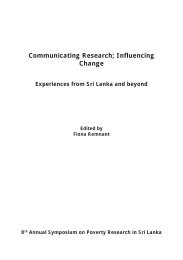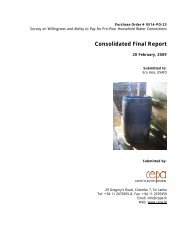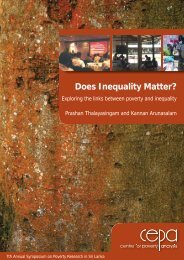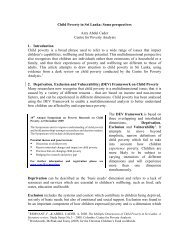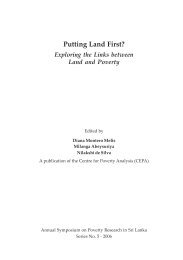Involuntary Displacement and Resettlement â Policy and ... - CEPA
Involuntary Displacement and Resettlement â Policy and ... - CEPA
Involuntary Displacement and Resettlement â Policy and ... - CEPA
- No tags were found...
You also want an ePaper? Increase the reach of your titles
YUMPU automatically turns print PDFs into web optimized ePapers that Google loves.
The government had to identify l<strong>and</strong>s close to the affected villages <strong>and</strong>resettle them irrespective of their pre-tsunami l<strong>and</strong> ownership. The idea wasto get donor assistance to build new houses on government identified l<strong>and</strong>s.Guidelines were set by the government on the floor size (minimum 500sq.ft.) <strong>and</strong> these new houses would be provided with facilities such aselectricity, drinking water, sanitation, drainage <strong>and</strong> access to road systems.A feature of this policy was ‘house for house’, even large extended familieswho had previously lived together were entitled to receive only one newhouse, irrespective of how big their former house had been.<strong>Resettlement</strong> was sometimes delayed due to unavailability of suitable l<strong>and</strong>sclose to affected villages. Households that had been within the buffer zonewere in temporary shelters for years. This situation made the governmentrevise policy in 2006 <strong>and</strong> the buffer zone was relaxed. According to the newpolicy, the buffer zone was less than 100m in certain areas <strong>and</strong> morehouseholds were allowed to rebuild their own houses rather than waiting intemporary shelter with the hope of being provided a new house.However, the changes in housing policy variably affected potentialbeneficiaries. Those who had had small houses (less than 500 sq.ft.) <strong>and</strong> didnot have l<strong>and</strong>/house ownership before the tsunami have been affectedadversely if they were not within the new buffer zone, by becomingineligible for a new house, even though some of them had spent more thana year in temporary shelter. On the other h<strong>and</strong>, some households hadalready resettled in another location but were able to get donor assistanceto also rebuild their former house. These households have benefited fromthe policy.Focus group discussions with the fisher community revealed that theirpriority was housing, followed by livelihood restoration. However, theattention paid to livelihood restoration by the government was less than thatpaid to housing. There was no well planned, properly coordinatedpolicy/strategy for livelihood restoration of the affected fishers.5 Current Housing SituationThe findings of the followup survey reveal that 51% have rebuilt theirdamaged or destroyed houses <strong>and</strong> are currently living there, while 40% ofhouseholds have resettled in a different location. The survey also revealedthat some households have rebuilt as well as resettled in another location,88



